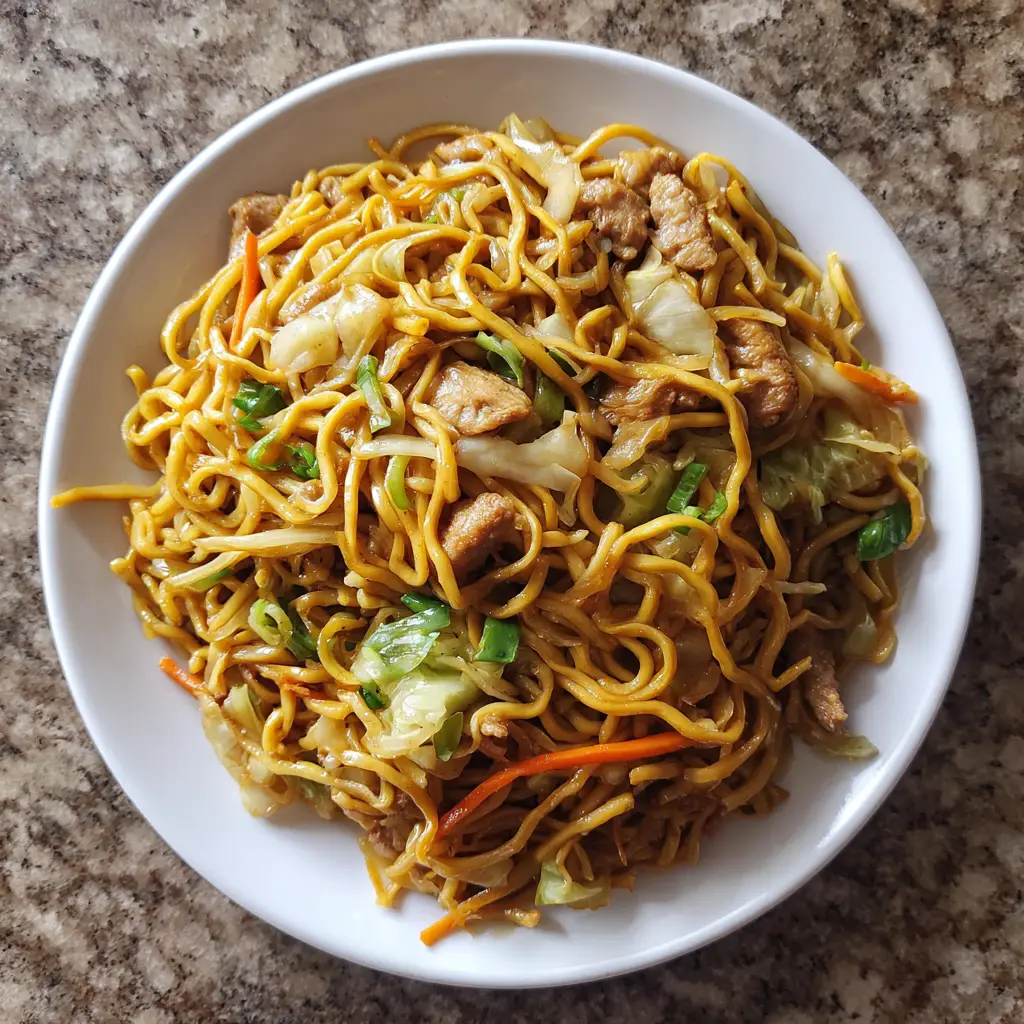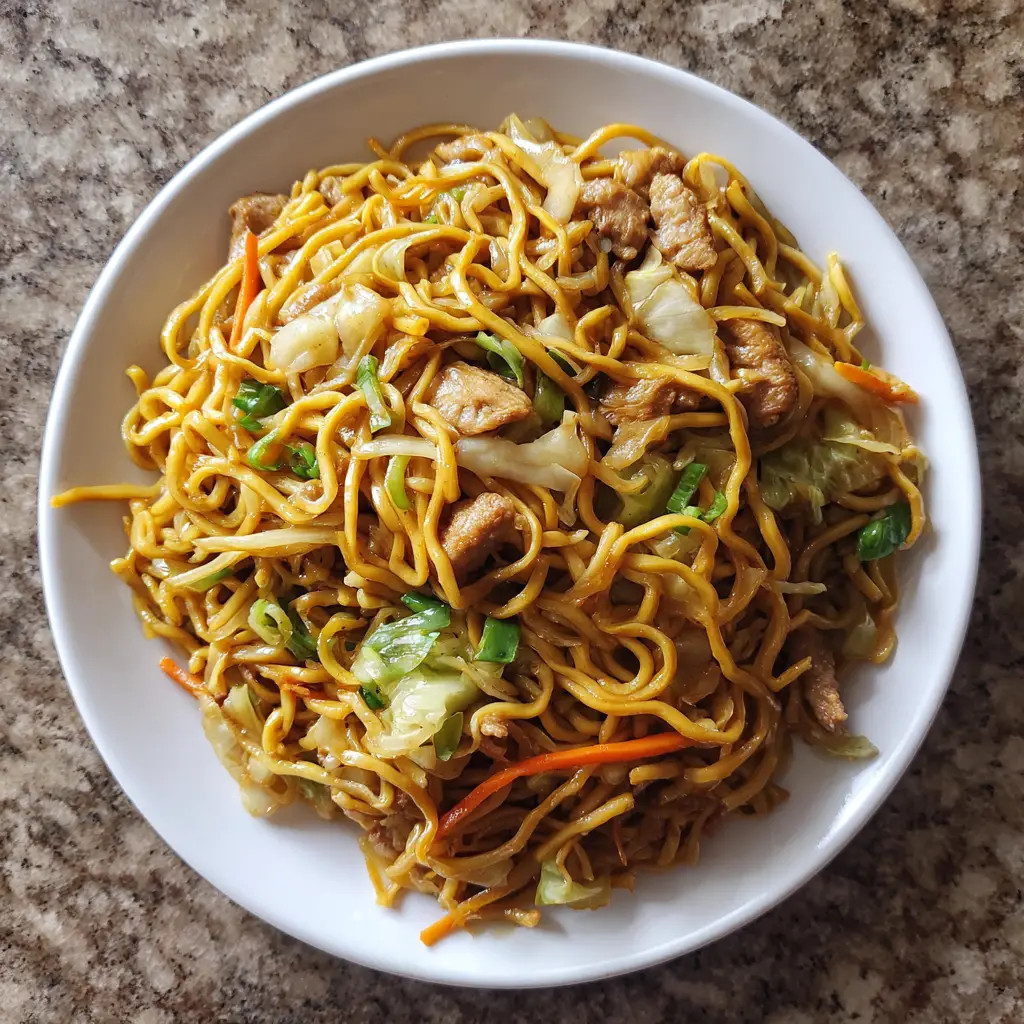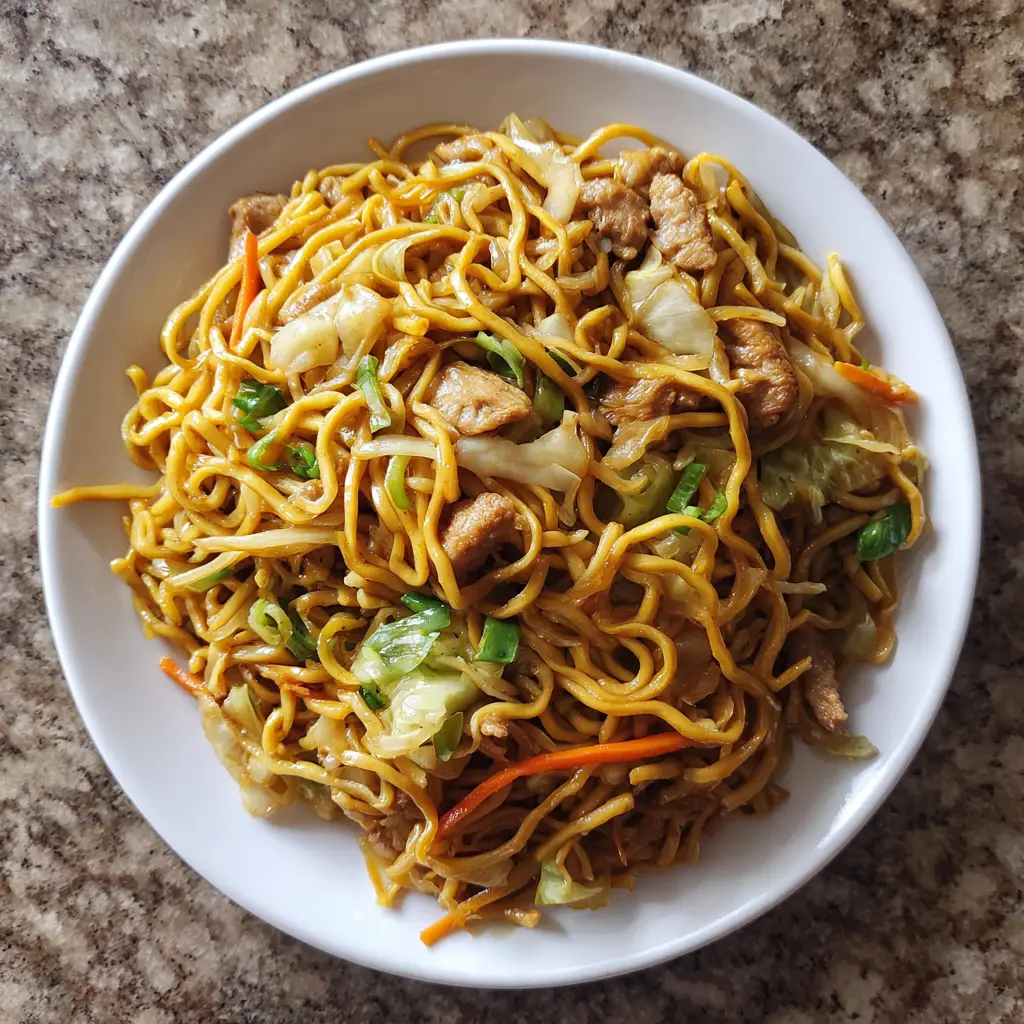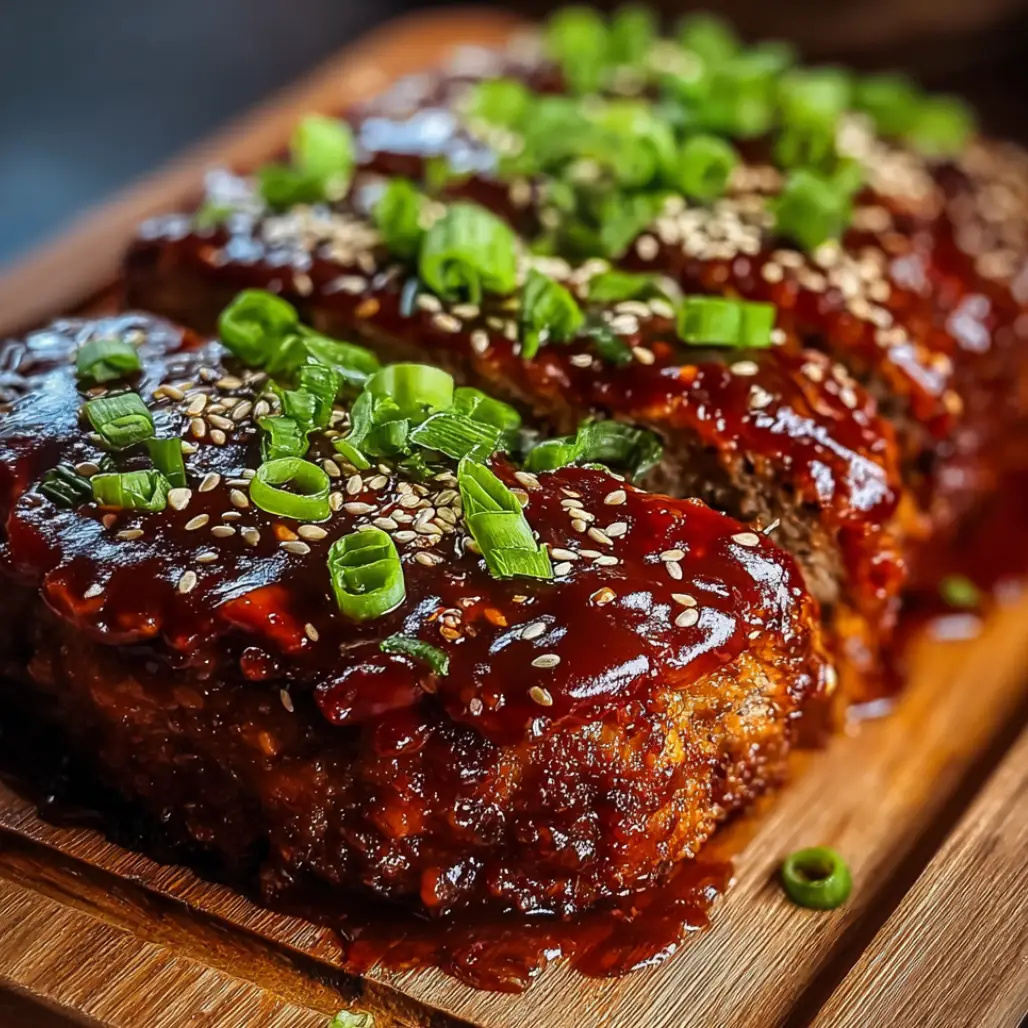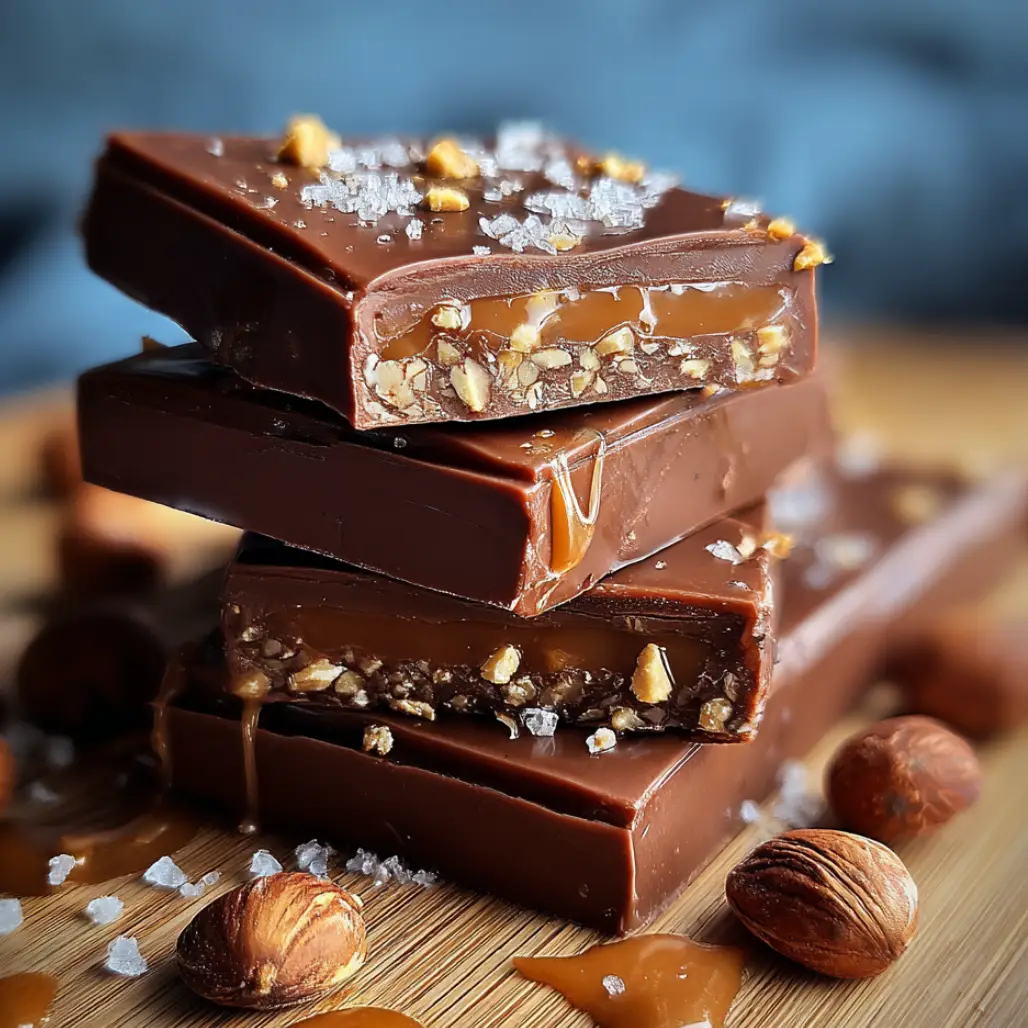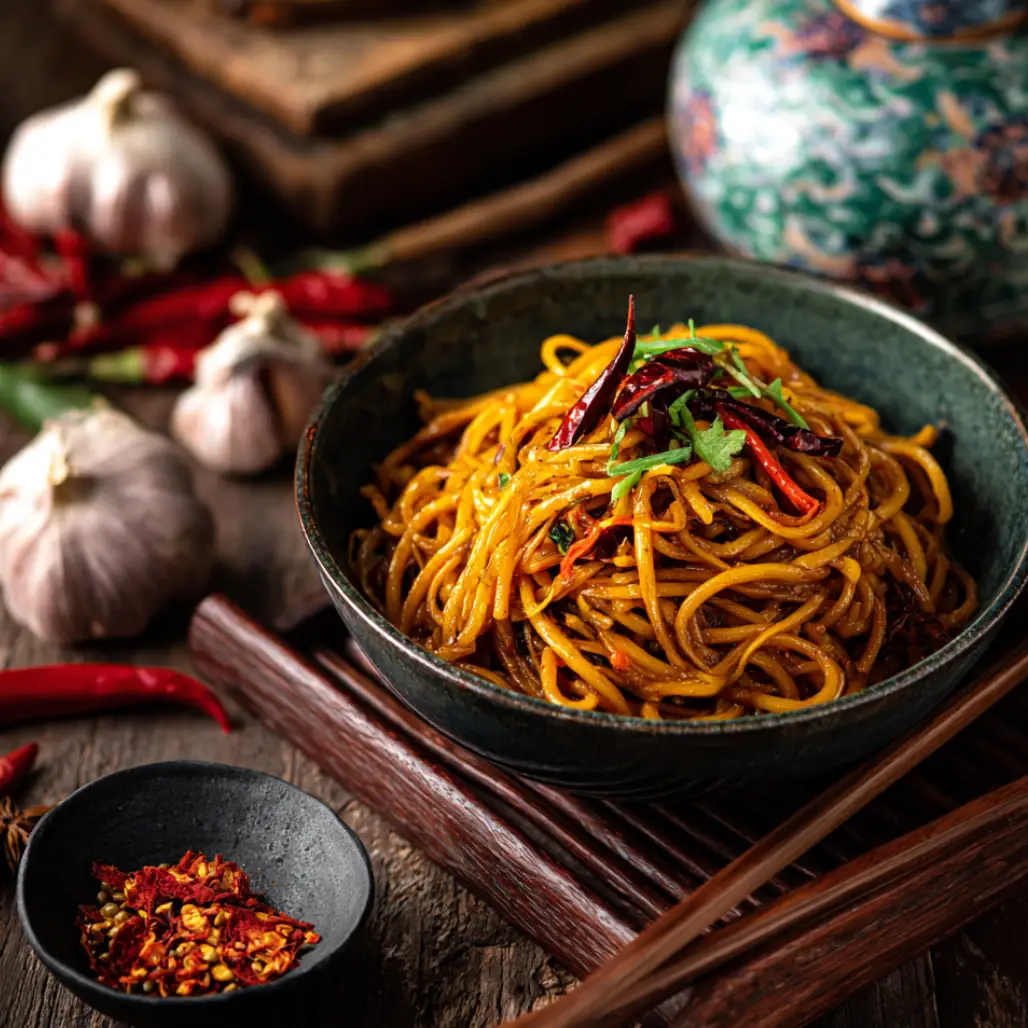| Prep Time | Cook Time | Total Time | Serves |
|---|---|---|---|
| 10 minutes | 15 minutes | 25 minutes | 4 |
Why This Panda Express Chow Mein Recipe Works
The exceptional success of this Panda Express chow mein recipe stems from its faithful recreation of the precise cooking techniques and ingredient ratios that define the restaurant’s signature dish because understanding these fundamental elements allows home cooks to achieve professional-quality results while maintaining the authentic character that makes this dish so beloved. The choice of yakisoba noodles provides the ideal texture foundation because these wheat-based noodles offer the perfect balance of firmness and chewiness that characterizes authentic Panda Express chow mein while remaining accessible to home cooks through most grocery stores.
The vegetable combination creates essential flavor complexity because cabbage, celery, and onions each contribute distinct textures and tastes that work harmoniously to create the characteristic crunch and sweetness that defines this Panda Express chow mein experience. The high-heat cooking method develops crucial flavor depth because quick stir-frying creates the subtle char and caramelization that gives restaurant-style chow mein its distinctive taste while preserving the vegetable textures that provide satisfying contrast to the tender noodles.
The sauce composition balances sweet and savory elements because soy sauce provides umami depth while brown sugar adds the subtle sweetness that makes this Panda Express chow mein recipe so appealing to diverse palates. The timing of sauce addition ensures proper distribution because introducing the liquid components at the correct moment allows for even coating while preventing the noodles from becoming soggy or overly sauced.
This recipe produces consistent results because the straightforward technique and common ingredients eliminate variables that could affect outcome while the simplified preparation method makes it accessible to cooks of all skill levels. The scalability of this Panda Express chow mein recipe allows for easy modification because the basic ratios can be multiplied or adapted to accommodate different serving sizes or dietary preferences without compromising the essential character that makes this dish so satisfying.
Essential Ingredients for Perfect Panda Express Chow Mein
For the Noodles:
- 3 packages (5.6 ounces each) yakisoba noodles (discard seasoning packets)
- 1 tablespoon vegetable oil (for cooking noodles)
For the Vegetables:
- 1 medium yellow onion (thinly sliced)
- 3 stalks celery (sliced diagonally)
- 3 cups green cabbage (thinly sliced)
- 2 cloves garlic (minced)
- 1 teaspoon fresh ginger (minced)
For the Sauce:
- 3 tablespoons low-sodium soy sauce
- 1 tablespoon oyster sauce
- 1 tablespoon brown sugar
- 1/2 teaspoon sesame oil
- 1/4 teaspoon white pepper
- 1/4 teaspoon salt (or to taste)
For Cooking:
- 3 tablespoons vegetable oil (for stir-frying)
- 2 green onions (chopped, for garnish)
Creating authentic Panda Express chow mein requires selecting the right ingredients because each component contributes specific characteristics that define the final dish’s flavor and texture profile. Yakisoba noodles form the foundation because their wheat-based composition and slightly oily coating create the ideal texture that most closely matches the restaurant version while providing the substantial mouthfeel that makes this dish so satisfying.
Fresh vegetables provide essential crunch and flavor contrast because cabbage offers mild sweetness and satisfying texture, celery contributes refreshing crispness and subtle flavor, while onions add aromatic depth and natural sweetness when properly caramelized. Quality soy sauce serves as the primary flavor base because its umami richness provides the savory foundation that defines this Panda Express chow mein recipe while lower sodium varieties allow better control over salt levels.
Oyster sauce adds crucial depth and complexity because its rich, slightly sweet character enhances the overall flavor profile while contributing the glossy finish that gives restaurant-style chow mein its appealing appearance. Brown sugar provides the subtle sweetness that balances the savory elements because this natural sweetener creates the characteristic flavor profile that makes Panda Express chow mein so universally appealing.
The Art of Creating Perfect Panda Express Chow Mein
Mastering the preparation of Panda Express chow mein involves understanding the critical timing and temperature control that distinguish restaurant-quality results from ordinary home cooking because this knowledge allows you to recreate the precise textures and flavors that make this dish so memorable. The preparation sequence requires careful organization because stir-frying happens quickly and having all ingredients properly prepared ensures smooth execution while preventing overcooking that could compromise the final texture.
Heat management represents the most crucial technical aspect because high temperature cooking creates the characteristic flavor development and texture contrast that defines authentic Panda Express chow mein while insufficient heat results in steamed rather than properly stir-fried vegetables. The order of ingredient addition affects final quality because each component requires different cooking times to achieve optimal texture and flavor development.
Noodle preparation technique influences the final texture because proper cooking and handling prevents the mushy consistency that can ruin an otherwise perfect dish while ensuring the noodles maintain their distinctive chewiness. Understanding sauce integration timing ensures even distribution because adding liquid components at the correct moment allows for proper coating while maintaining the ideal consistency that characterizes this Panda Express chow mein recipe.
Vegetable cutting consistency affects cooking uniformity because similarly sized pieces cook evenly while varied dimensions create uneven textures that detract from the professional appearance and eating experience. The balance between cooking time and vegetable crispness requires careful attention because proper timing preserves the fresh crunch while developing the subtle caramelization that enhances flavor complexity.
Step-by-Step Instructions for Panda Express Chow Mein
Preparing Your Ingredients and Equipment
Begin by gathering all ingredients and preparing your workspace because efficient organization is essential for successful stir-frying that requires quick execution and precise timing. Remove the yakisoba noodles from their packages and discard the seasoning packets because these often contain artificial flavors that would interfere with the authentic Panda Express chow mein taste profile you want to achieve.
Slice the onion into thin strips and cut the celery diagonally into bite-sized pieces because consistent cutting ensures even cooking while the diagonal cuts create attractive presentation and optimal surface area for flavor development. Shred the cabbage into thin strips similar to coleslaw because this size allows for quick cooking while maintaining the characteristic crunch that defines this Panda Express chow mein recipe.
Professional Tip: Prepare all vegetables before beginning any cooking because stir-frying happens quickly and stopping to cut ingredients during cooking will result in overcooked components and uneven textures.
Key Points: Proper preparation prevents rushed cooking that could compromise the texture and flavor development essential for authentic Panda Express chow mein results.
Creating the Flavor Base
Combine soy sauce, oyster sauce, brown sugar, sesame oil, white pepper, and salt in a small bowl because pre-mixing the sauce ensures even flavor distribution while preventing the burning that can occur when individual liquid components are added directly to the hot pan. Whisk the mixture thoroughly because complete integration creates a smooth sauce that coats the noodles evenly while preventing clumping of the brown sugar that could create sweet spots in the finished dish.
Set the prepared sauce aside within easy reach of your cooking area because quick access during stir-frying prevents delays that could result in overcooked vegetables or improperly integrated flavors. Taste the sauce mixture and adjust seasonings if desired because personal preference should guide the final flavor balance of your Panda Express chow mein recipe.
Professional Tip: Make extra sauce if you prefer more heavily sauced noodles because the basic recipe creates a light coating that allows the noodle and vegetable flavors to shine through prominently.
Key Points: Pre-mixed sauce prevents uneven flavor distribution because adding individual liquid components during high-heat cooking often results in poor integration and inconsistent taste throughout the dish.
Preparing the Noodles
Bring a large pot of water to boiling and add the yakisoba noodles because proper cooking technique ensures the ideal texture that matches the restaurant version while preventing the mushy consistency that can ruin this Panda Express chow mein recipe. Cook the noodles for exactly 2-3 minutes or until they separate and become tender because overcooking creates a soft texture that cannot withstand the stir-frying process without falling apart.
Drain the noodles immediately and rinse with cool water because this stops the cooking process while removing excess starch that could make the final dish gummy rather than maintaining the distinct noodle texture. Shake the colander thoroughly to remove excess water because any remaining moisture will create steam during stir-frying that prevents proper browning and flavor development.
Professional Tip: Slightly undercook the noodles because they will continue cooking during the stir-frying process, and starting with firmer noodles ensures the final texture matches the restaurant standard.
Key Points: Proper noodle preparation creates the foundation for authentic texture because overcooked or improperly drained noodles cannot achieve the characteristic chewiness that defines quality Panda Express chow mein.
Executing the Stir-Fry Technique
Heat a large wok or heavy skillet over high heat and add vegetable oil because proper temperature and fat content create the conditions necessary for authentic stir-frying that develops the characteristic flavors and textures. Add the minced garlic and ginger first because these aromatics require brief cooking to release their flavors while avoiding the burning that would create bitter notes in your Panda Express chow mein recipe.
Immediately add the sliced onions and stir constantly for 1-2 minutes because this initial cooking develops sweetness while beginning the caramelization process that contributes essential flavor depth. Add the celery and cabbage and continue stir-frying for another 2-3 minutes because these vegetables require longer cooking to achieve the proper texture while maintaining their characteristic crunch.
Professional Tip: Keep ingredients moving constantly during stir-frying because stationary food burns quickly at high temperatures while continuous motion ensures even cooking and proper flavor development.
Key Points: High heat cooking creates the subtle char and caramelization that distinguishes restaurant-style chow mein because insufficient temperature results in steamed rather than properly stir-fried vegetables.
Combining and Finishing the Dish
Add the prepared noodles to the vegetable mixture and toss everything together because this integration allows the noodles to absorb vegetable flavors while heating through completely. Pour the prepared sauce over the noodle and vegetable mixture and stir vigorously because thorough mixing ensures even coating while preventing sauce pooling that could create unevenly flavored portions.
Continue stir-frying for 2-3 more minutes because this final cooking period allows the sauce to coat everything evenly while heating all components to serving temperature. Remove from heat immediately when the noodles are heated through and the sauce is evenly distributed because overcooking at this stage can make the noodles mushy while concentrating the sauce flavors excessively.
Professional Tip: Taste and adjust seasoning during the final mixing stage because this is your last opportunity to perfect the flavor balance before serving your Panda Express chow mein.
Key Points: Proper sauce integration creates the glossy coating and balanced flavor that characterizes authentic Panda Express chow mein because inadequate mixing results in dry spots and uneven taste distribution.
Professional Tips for Perfect Panda Express Chow Mein
Temperature control represents the most critical factor for authentic results because restaurant-style wok cooking requires intense heat that most home kitchens struggle to achieve, so maximize your burner output and preheat your pan thoroughly before beginning the stir-frying process. Use the largest burner on your stove and ensure adequate ventilation because high-heat cooking generates significant smoke while proper air circulation prevents overwhelming your kitchen environment.
Ingredient preparation timing affects final quality because all components must be ready before cooking begins, and stopping to prepare items during stir-frying invariably results in overcooked elements that compromise the overall dish quality. Practice mise en place by having vegetables cut, sauce mixed, and noodles cooked before heating your pan because this professional approach ensures smooth execution while preventing the rushed cooking that creates poor results.
Noodle selection significantly impacts authenticity because yakisoba noodles provide the closest match to restaurant texture, but acceptable substitutes include fresh chow mein noodles or even ramen noodles with seasoning packets discarded. Avoid using dried pasta or rice noodles because these alternatives create different textures that don’t match the characteristic chewiness of authentic Panda Express chow mein.
Pan selection influences cooking success because woks provide ideal heat distribution and capacity, but large skillets can produce excellent results if used properly with adequate heat and constant motion. Carbon steel or cast iron pans work best because these materials retain and distribute heat effectively while non-stick surfaces may not withstand the high temperatures necessary for proper stir-frying.
Serving timing affects quality because this Panda Express chow mein recipe is best enjoyed immediately while the vegetables retain their crunch and the noodles maintain their optimal texture. Plan your meal timing accordingly because holding finished chow mein for extended periods results in softened vegetables and continued sauce absorption that changes the intended texture balance.
Creative Variations of Panda Express Chow Mein
Transform your basic Panda Express chow mein into exciting new variations by incorporating additional ingredients and flavor modifications because these adaptations allow you to customize the dish for different preferences while maintaining the essential character that makes this recipe so appealing. Protein-enhanced Panda Express chow mein creates a complete meal because adding sliced chicken, beef, shrimp, or tofu transforms the side dish into a satisfying main course while providing additional nutrition and substance.
Vegetable-loaded Panda Express chow mein increases nutritional value because incorporating carrots, bell peppers, snap peas, or mushrooms adds color, texture, and vitamins while maintaining the authentic flavor profile. These additions work particularly well because they complement the existing vegetable combination while providing visual appeal and enhanced nutritional benefits.
Spicy Panda Express chow mein appeals to heat lovers because adding red pepper flakes, sriracha, or fresh chilies creates exciting flavor dimensions while preserving the fundamental character of the original recipe. Adjust spice levels gradually because individual tolerance varies significantly, and you can always add more heat but cannot easily remove excessive spicing once incorporated.
Healthier Panda Express chow mein reduces calories and increases nutrition because substituting vegetable noodles like zucchini spirals or shirataki noodles creates a lighter version while using reduced-sodium soy sauce and eliminating added sugar makes the dish more diet-friendly. These modifications work well because the vegetable and sauce flavors remain prominent while the overall dish becomes more nutritionally balanced.
Regional fusion Panda Express chow mein incorporates international flavors because adding kimchi for Korean influence, curry powder for Indian notes, or coconut aminos for Southeast Asian character creates unique fusion dishes that maintain the basic preparation method while offering new taste experiences.
Gluten-free Panda Express chow mein accommodates dietary restrictions because using rice noodles or gluten-free pasta alternatives combined with tamari instead of soy sauce creates an inclusive version that everyone can enjoy while maintaining the essential flavors and textures that define this beloved dish.
Perfect Pairing Ideas for Panda Express Chow Mein
The versatile nature of Panda Express chow mein makes it an ideal companion for numerous main dishes and beverages because its balanced flavor profile complements both bold and subtle tastes while its substantial texture provides satisfying contrast to various protein preparations. Traditional Chinese entrees create authentic combination meals because dishes like orange chicken, kung pao chicken, or beef and broccoli pair naturally with this chow mein while recreating the complete Panda Express dining experience at home.
Grilled proteins work exceptionally well because the smoky flavors complement the savory noodles while providing textural contrast that creates more interesting meals. Consider serving your Panda Express chow mein alongside grilled chicken, salmon, or pork because these preparations offer clean flavors that don’t compete with the noodle dish while adding protein content that transforms the combination into a complete meal.
For those interested in creating complete Asian-inspired dining experiences, explore the creative appetizer options at Tasty Middles because these recipes offer complementary flavors and textures that would enhance your Panda Express chow mein meal while providing variety and visual appeal.
Soup pairings create comforting meal combinations because clear broths like wonton soup or hot and sour soup provide warming elements that complement the substantial noodles while cleansing the palate between bites. The liquid component also helps balance the richness of the chow mein while adding hydration and warmth to the overall dining experience.
Vegetable side dishes enhance nutritional value because steamed broccoli, sautéed bok choy, or fresh cucumber salad add vitamins and minerals while providing contrasting textures and flavors that make meals more interesting and balanced. These lighter accompaniments work particularly well because they don’t compete with the chow mein flavors while contributing fresh elements that brighten the overall meal.
Beverage selections should complement rather than compete with the savory flavors because green tea, jasmine tea, or sparkling water with lemon provide refreshing contrast while beer or light wines can enhance the dining experience without overwhelming the delicate balance of flavors in your Panda Express chow mein.
Discover More Asian-Inspired Recipes and Cooking Techniques
Expanding your Asian cooking repertoire beyond Panda Express chow mein opens up exciting culinary possibilities because understanding fundamental techniques like stir-frying, sauce balancing, and proper noodle cooking creates the foundation for mastering numerous dishes from various Asian cuisines. The skills developed through perfecting this chow mein recipe translate directly to other stir-fried dishes because the basic principles of high-heat cooking, proper timing, and ingredient preparation remain consistent across many Asian preparations.
Noodle dishes represent a particularly rich category for exploration because different Asian cultures have developed unique approaches to combining noodles with vegetables, proteins, and sauces while each tradition offers distinct flavor profiles and cooking techniques that expand your culinary knowledge. Understanding how to work with various noodle types allows confident experimentation because this knowledge enables adaptation of techniques across different ingredient combinations.
The art of sauce creation extends far beyond this single recipe because Asian cuisines utilize complex combinations of soy sauce, rice wine, vinegar, and sugar to create countless flavor profiles that can transform simple ingredients into extraordinary dishes. Learning to balance sweet, salty, sour, and umami elements provides the foundation for creating authentic Asian flavors because these fundamental taste relationships guide successful recipe development.
For those interested in exploring sophisticated marinades and sauce techniques that complement Asian cooking, the expertly crafted collection at Solush Recipes demonstrates how traditional ingredients can be combined in innovative ways that enhance flavor while maintaining authenticity.
Stir-frying techniques apply to countless vegetable and protein combinations because this cooking method preserves nutrients while developing complex flavors through proper heat management and timing. Mastering these fundamental skills enables confident adaptation of recipes because understanding how different ingredients respond to high-heat cooking allows successful modification of existing recipes to accommodate available ingredients or personal preferences.
Regional variations within Asian cuisines offer endless inspiration because each culture has developed unique approaches to similar ingredients while local preferences and available products have created distinctive flavor profiles that reflect geographic and cultural influences.
Proper Storage Guidelines for Panda Express Chow Mein
Understanding proper storage techniques for Panda Express chow mein ensures that you can maintain optimal flavor and texture while extending the usability of this dish because proper handling preserves the characteristics that make this recipe so appealing. Fresh Panda Express chow mein maintains peak quality when served immediately because the contrast between tender noodles and crisp vegetables is most pronounced when the dish is at optimal serving temperature.
Room temperature storage works for short periods because this Panda Express chow mein remains safe and appealing for up to two hours at room temperature, making it suitable for buffet serving and casual dining situations where immediate refrigeration isn’t practical. However, extended room temperature storage should be avoided because the vegetables continue softening while food safety considerations require refrigeration for longer storage periods.
Refrigerator storage extends usability because properly stored leftover Panda Express chow mein remains safe and reasonably appealing for up to three days when placed in airtight containers that prevent moisture loss and odor absorption. Cool the dish completely before refrigerating because hot food can raise refrigerator temperatures while creating condensation that affects texture quality.
Reheating techniques significantly impact quality because proper methods can restore much of the original appeal while inappropriate heating creates disappointing results that don’t reflect the dish’s potential. Stir-frying leftover Panda Express chow mein in a hot pan with a small amount of oil provides the best results because this method re-crisps the vegetables while restoring the proper texture balance.
Microwave reheating works for convenience but produces different results because steam heating softens vegetables while changing the texture profile that defines quality chow mein. If using microwave heating, use short intervals and stir frequently because this approach minimizes texture degradation while ensuring even heating throughout the dish.
Freezing isn’t recommended for this Panda Express chow mein because the high water content in vegetables creates ice crystals that damage cell structure, resulting in mushy texture when thawed that cannot be restored through reheating techniques.
The Science Behind Panda Express Chow Mein’s Appeal
The remarkable popularity of Panda Express chow mein stems from scientific principles of flavor development and texture contrast that create deeply satisfying eating experiences because understanding these mechanisms helps explain why this simple dish achieves such broad appeal across diverse populations. The Maillard reactions that occur during high-heat stir-frying create complex flavor compounds because the interaction between amino acids and reducing sugars produces hundreds of new taste molecules that contribute to the characteristic “wok hei” or breath of the wok that defines authentic stir-fried dishes.
Texture contrast plays a crucial psychological role in food satisfaction because the combination of chewy noodles, crisp vegetables, and smooth sauce creates multiple sensory experiences that keep the palate engaged while preventing the monotony that can occur with uniform textures. This variety stimulates different mechanoreceptors in the mouth because each component activates different sensory pathways that contribute to overall eating pleasure.
Umami development through soy sauce and oyster sauce creates the savory depth that makes this Panda Express chow mein so satisfying because these ingredients contain glutamates and nucleotides that trigger specific taste receptors associated with protein and nutrient density. This biological response explains why dishes rich in umami create feelings of satiation and satisfaction that extend beyond simple caloric content.
The balance of sweet and salty flavors appeals to fundamental taste preferences because humans are evolutionarily programmed to seek these flavor combinations that historically indicated safe, nutritious food sources. The brown sugar in this recipe provides just enough sweetness to enhance rather than overwhelm the savory elements because this balance creates the flavor harmony that makes the dish so universally appealing.
Starch gelatinization in the noodles contributes to texture satisfaction because properly cooked wheat noodles achieve the ideal balance between firmness and tenderness that provides optimal mouthfeel. Understanding this process allows cooks to achieve consistent results because knowledge of how starch molecules behave under different cooking conditions enables precise texture control.
Temperature effects on flavor perception explain why this Panda Express chow mein tastes best when served hot because elevated temperatures enhance the volatility of aromatic compounds while heat affects taste receptor sensitivity in ways that maximize flavor perception.
Troubleshooting Common Panda Express Chow Mein Issues
Creating perfect Panda Express chow mein requires understanding common problems and their solutions because even experienced cooks encounter challenges that can affect both flavor and texture of this seemingly simple dish. Mushy or overcooked noodles typically result from excessive cooking time or inadequate draining because these issues create soft textures that cannot withstand stir-frying without falling apart or becoming gummy rather than maintaining the characteristic chewiness.
If your noodles become too soft, reduce initial cooking time and ensure thorough draining because these adjustments prevent overcooking while removing excess moisture that contributes to texture problems. For future preparations, slightly undercook the noodles because they continue cooking during stir-frying, and starting with firmer texture ensures the final result matches restaurant standards.
Vegetables that are too soft or lack crunch usually indicate insufficient heat or excessive cooking time because proper stir-frying requires intense heat and brief cooking periods to maintain texture while developing flavor. Increase your heat setting and reduce cooking time because these modifications create the high-temperature environment necessary for authentic results while preserving vegetable integrity.
Uneven sauce distribution often stems from inadequate mixing or sauce that’s too thick because these factors prevent proper coating while creating some portions that are over-sauced and others that remain dry. Add sauce gradually while mixing constantly because this technique ensures even distribution while preventing sauce pooling that creates inconsistent flavor throughout your Panda Express chow mein.
Bland or underseasoned flavor typically indicates insufficient sauce or improper seasoning balance because this recipe relies on the sauce mixture to provide most of the dish’s flavor complexity. Taste and adjust seasonings during cooking because personal preference should guide the final flavor profile while additional soy sauce or salt can correct underseasoning issues.
Excessive saltiness results from high-sodium ingredients or over-concentration of sauce because both soy sauce and oyster sauce contain significant salt content that can become overwhelming if not properly balanced. Use low-sodium versions of sauce ingredients and add liquid gradually because these approaches provide better control over final salt levels while preventing over-seasoning that cannot be easily corrected.
Dry or sticky noodles often indicate inadequate oil or improper heat management because both factors affect how the noodles behave during stir-frying while insufficient lubrication causes sticking and uneven cooking that affects the final texture of your Panda Express chow mein.
Additional Inspirations for Asian Cooking Mastery
The principles that make Panda Express chow mein so successful can inspire broader exploration of Asian cooking techniques because understanding fundamental concepts like heat management, sauce balancing, and ingredient timing opens up countless possibilities for creating authentic dishes from various Asian cuisines. Traditional stir-frying methods represent just one aspect of Asian cooking because steaming, braising, and deep-frying each offer unique advantages for different ingredients while contributing to the diverse texture and flavor profiles that characterize regional cuisines.
Sauce development represents a particularly rich area for exploration because Asian cuisines utilize complex combinations of fermented ingredients, aromatic oils, and balancing elements to create distinctive flavor profiles that transform simple ingredients into memorable dishes. Understanding how different sauce components interact allows confident experimentation because this knowledge enables adaptation of basic formulas to create personalized versions that reflect individual taste preferences.
Noodle varieties from different Asian cultures offer exciting opportunities for creative adaptation because each type brings unique characteristics that can completely transform familiar recipes while maintaining fundamental preparation principles. Rice noodles, soba, udon, and regional specialties each provide different textures and flavors because their composition and processing methods create distinct eating experiences that expand culinary possibilities.
For those interested in exploring more breakfast and brunch options that incorporate Asian flavors, the comprehensive collection at Solush Recipes offers numerous ideas for incorporating these techniques into morning meals while creating fusion dishes that blend familiar comfort foods with exciting international influences.
Regional cooking styles within Asia provide endless inspiration because geographic and cultural differences have created unique approaches to similar ingredients while local preferences and available products have influenced the development of distinctive flavor profiles that reflect historical and environmental factors. Understanding these regional variations enables appreciation of diversity while providing guidance for authentic recipe adaptation.
Modern fusion approaches allow creative interpretation of traditional techniques because contemporary chefs successfully combine Asian methods with local ingredients while maintaining respect for fundamental principles that ensure authentic flavors and textures. This approach encourages experimentation because it demonstrates how traditional techniques can be adapted to create new dishes that honor culinary heritage while reflecting personal creativity.
For those looking to expand their entertaining repertoire with complementary side dishes, the collection at Tasty Middles provides numerous options that would pair beautifully with Asian-inspired main courses while creating cohesive dining experiences that showcase diverse flavors and cooking techniques.
Conclusion
This comprehensive exploration of Panda Express chow mein demonstrates how mastering fundamental stir-frying techniques and understanding proper ingredient relationships can recreate beloved restaurant favorites while providing the foundation for countless culinary variations because the skills developed through perfecting this recipe translate directly to numerous other Asian dishes. The beauty of this Panda Express chow mein recipe lies not only in its authentic flavor and satisfying texture but also in its accessibility because simple ingredients and straightforward techniques make restaurant-quality results achievable for home cooks while the quick preparation time fits easily into busy schedules.
Understanding the science behind successful stir-frying empowers confident recipe adaptation because knowledge of how heat, timing, and ingredient interactions affect final results allows customization for personal preferences while maintaining the essential characteristics that make this dish so appealing. The techniques demonstrated in this Panda Express chow mein recipe apply to countless other preparations because mastering high-heat cooking, proper sauce integration, and vegetable texture management provides the skills necessary for exploring diverse Asian cuisines with confidence.
Regular practice with this Panda Express chow mein will develop your stir-frying instincts and deepen your appreciation for Asian cooking principles because repeated preparation builds muscle memory while teaching you to recognize optimal texture, proper timing, and ideal flavor balance that distinguish exceptional dishes from ordinary alternatives. The investment in understanding these fundamental techniques pays dividends in improved cooking skills because the principles learned through mastering this recipe enable successful adaptation of countless other Asian dishes while building confidence in high-heat cooking methods.
Whether you’re seeking to recreate nostalgic takeout memories, explore Asian cooking techniques, or simply enjoy a delicious and satisfying meal that comes together quickly, this Panda Express chow mein recipe provides the perfect introduction to authentic stir-frying while delivering the familiar flavors that make this dish such an enduring favorite. The knowledge and skills gained from perfecting this recipe will serve as stepping stones to more advanced Asian cooking because understanding these fundamental principles creates the foundation for lifelong exploration and enjoyment of diverse culinary traditions that celebrate the transformative power of proper technique applied to quality ingredients, ultimately bringing both satisfaction and cultural appreciation to your home kitchen adventures.

